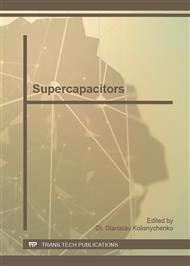p.1767
p.1772
p.1779
p.1787
p.1791
p.1797
p.1804
p.1810
p.1816
Supercapacitor from Nitrogen-Doped Carbon Nanotubes
Abstract:
CNTs were treated with hydrazine hydrate and diethylenetriamine, respectively. Scanning electron spectroscopy (SEM) observation showed that the doped CNTs kept the length/diameter ratio of pristine CNTs. X-ray photoelectron spectroscopy (XPS) characterized that nitrogen can be doped to CNTs. XPS analysis further indicated that C/N atomic ratio of CNTs treated by hydrazine hydrate is 95/2, four times of CNTs treated by diethylenetriamine, which is 96/0.5. The hydrophilicity for N-doped CNTs (N-CNTs) is much improved and enhanced by increasing N proportion. As electrode material of supercapacitor, nitrogen functional groups contribute pseudo-Faradic capacitance, but its cyclic performance still need to be improved. Thanks to the good hydrophilicity for N-CNTs that improves the wettability of CNTs for electrolyte; the specific capacitance of N-CNTs is still slightly higher than pristine CNTs after cycling.
Info:
Periodical:
Pages:
1791-1796
Citation:
Online since:
November 2010
Authors:
Price:
Сopyright:
© 2011 Trans Tech Publications Ltd. All Rights Reserved
Share:
Citation:



